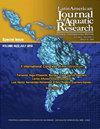东北太平洋白鲨(Carcharodon carcharias)的核遗传结构
IF 0.8
4区 农林科学
Q3 FISHERIES
Latin American Journal of Aquatic Research
Pub Date : 2023-07-02
DOI:10.3856/vol51-issue3-fulltext-2984
引用次数: 0
摘要
东北太平洋(NEP)的白鲨种群(Carcharodon carcharias)在基因上与世界其他地区不同。这种独特性源于成年人对加利福尼亚中部和瓜达卢佩岛聚集地的忠诚。加利福尼亚州中部和瓜达卢佩岛的白鲨之间也存在强大的线粒体遗传结构,这表明它们是雌性的。到目前为止,很少有使用核DNA的研究发现NEP白鲨种群遗传模式的证据,这可能表明这些鲨鱼表现出性别偏见的扩散。在这项研究中,我们使用来自南加州湾(SCB)、下加利福尼亚(包括Sebastian Vizcaino湾)、加利福尼亚湾和瓜达卢佩岛(GI)的样本,使用nDNA(即微卫星基因座)评估了NEP白鲨的遗传结构、连接性和遗传多样性。共有5个基因座在54个个体中成功地进行了基因分型。这项研究中发现的模式表明,所有地区的遗传多样性水平较低(观察到的杂合性:Ho=0.47),这可能是由于创始人效应。在本研究中,NEP部位存在轻微的遗传结构(FST=0.045,P=0.001),主要在SCB和GI部位之间确定。同胞分配分析表明,来自沿海地区的白鲨幼鲨之间出现完全和半同胞的概率较低和中等,这表明NEP中保育区之间存在高度的连通性。我们的研究结果表明,青少年可以掩盖沿海地区的遗传结构。本文章由计算机程序翻译,如有差异,请以英文原文为准。
Nuclear genetic structure of the white shark (Carcharodon carcharias) from the Northeastern Pacific
The Northeastern Pacific (NEP) population of white sharks (Carcharodon carcharias) is genetically distinct from the rest of the world. This uniqueness results from adult fidelity to central California and Guadalupe Island aggregations sites. The strong mitochondrial genetic structure between the white sharks of central California and Guadalupe Island is also present, which indicates female philopatry. To date, few studies using nuclear DNA have found evidence of genetic patterns in the NEP white shark population, which could indicate that these sharks exhibit sex-biased dispersal. In this study, we evaluated the genetic structure, connectivity, and genetic diversity of NEP white sharks using samples from the southern California Bight (SCB), Baja California (including Sebastian Vizcaino Bay), the Gulf of California, and Guadalupe Island (GI) using nDNA (i.e. microsatellite loci). A total of five loci were successfully genotyped in 54 individuals. The patterns found in this study indicated low levels of genetic diversity among all localities (observed heterozygosity: Ho = 0.47), likely due to a founder effect. A slight genetic structure was present for NEP localities in this study (FST = 0.045, P = 0.0001), mainly identified between the SCB and GI locations. A sibship assignment analysis indicated low and moderate probabilities of full- and half-siblings between white shark juveniles from coastal areas, suggesting a high degree of connectivity between nursery areas in the NEP. Our results suggest that juveniles can mask the genetic structure in coastal zones.
求助全文
通过发布文献求助,成功后即可免费获取论文全文。
去求助
来源期刊

Latin American Journal of Aquatic Research
FISHERIES-MARINE & FRESHWATER BIOLOGY
CiteScore
1.70
自引率
10.00%
发文量
44
审稿时长
4-8 weeks
期刊介绍:
Latin American Journal of Aquatic Research- LAJAR is the continuation of the journal Investigaciones Marinas (1970-2007) and is published since 2008 by the Escuela de Ciencias del Mar, Facultad de Ciencias del Mar y Geografía of the Pontificia Universidad Católica de Valparaíso. LAJAR is an “Open Access” journal that publishes in English language, original research articles, reviews and short communications on aquatic science, which contain the results of research conducted in aquaculture or in oceanic and coastal marine waters of Latin America.
The following topics are considered: Physical Oceanography, Chemical Oceanography, Marine Biogeochemistry, Marine Pollution and Toxicology, Marine Geology and Geophysics, Biological Oceanography, Fisheries and Aquaculture.
 求助内容:
求助内容: 应助结果提醒方式:
应助结果提醒方式:


